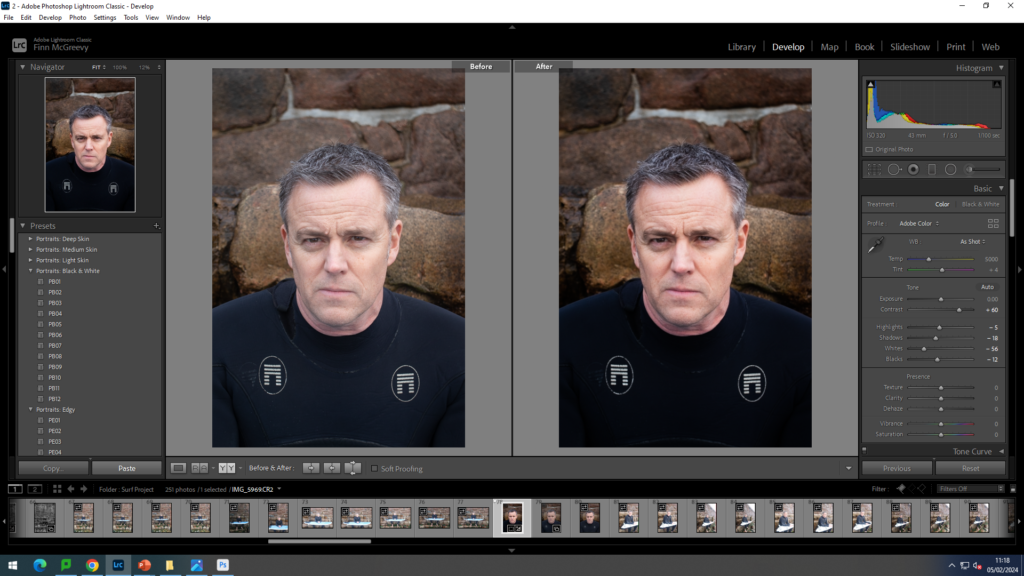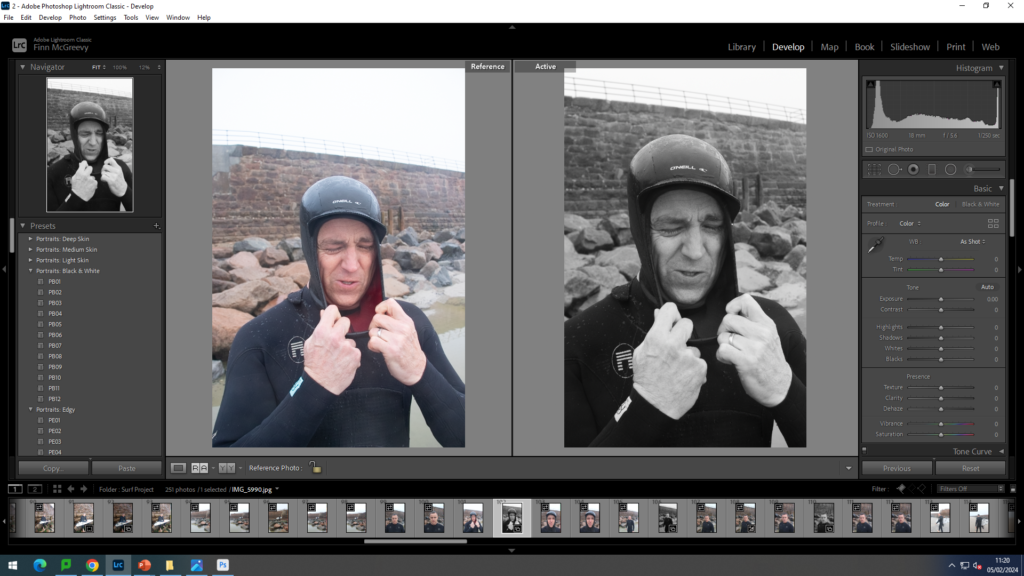To what extent are photographs an accurate portrayal of memories and the past?
“These photographs taken forty years ago and which I do not remember the time of the shooting…awakened in me a fear of something familiar and totally unknown…”
-C. Benitah- Photos Souvenirs (2017)
Since being invented in the mid-19th century, photography has served the world as the main way of collecting visual memories. Whether to capture personal or worldwide events, its development has been an important process for everyone. In this essay, I would like to explore how much accuracy photographs hold, when compared to the past. The quote above, taken from Carolle Bénitah’s project Photos Souvenirs, is a perfect portrayal of how photos act as memories. The contrast between the two phrases ‘something familiar and totally unknown‘, shows how Bénitah felt a sense of nostalgia when looking at the archives, however the feeling was mixed with something else entirely: a feeling of foreignness. Bénitah had a difficult childhood: growing up in a traditional, Moroccan household caused there to be a strict expectation of her: to grow up and become a traditionally flawless woman. I believe this quote perfectly summarises Bénitah’s project, since she manipulates these seemingly precise family snapshots to truly match the reality of her harsh past. The utilisation of multi- media methods (specifically embroidery using a red thread as seen in Photos Souvenirs) allowed Bénitah to present her actual memories in the staged photographs of her childhood over 40 years later, altering the innocent look that the snapshots have. Her work links in well with the question I want to investigate, since it is made up of her looking at these supposedly familiar pictures and then later correcting the mistakes by hand.
As most photographers know, photography is not a neutral observer but a reflection of the photographer’s perspective, suggesting photographs aren’t the past but perhaps more accurately a past, or how one person perceived the moment. The amateur visual of Bénitah’s family archives suggest the photographs were simply taken with the intention of creating a memory, perhaps captured by a parent or other close family member. This implies that the photographs are from the point of view from a single individual, reflecting their emotions in that moment and not of the people in the image. Carolle Bénitah is my chosen artist since she summarises the experience of looking at archives perfectly through her work. I believe that every individual has this experience when viewing archives from their own life, the feeling of familiarity being just as present as the feeling of strangeness.

In this photograph, Bénitah is about six years old and holding hands with her smiling brother, but an army of cockroaches surrounds the children, and their hands are bound together in a ball of red wool. Bénitah doesn’t express her true thoughts that went behind the manipulation of each photograph, leaving a lot of them up to the interpretation of the viewer. However, it is clear that Bénitah embroidered the images to show the truth behind them, indicating how their smiles were simply a pose for the picture. The red wool could be a representation of love, the love she had for her brother which is what made them so close. Or it could be a portrayal of violence or even blood, perhaps suggesting that they were simply close due to being family (the idea of being connected by blood) or even perhaps to support each other during hard times. Moreover, a line in The Photography Reader states “meanings and memories may change with time” (Kuhn 2003:397), which creates the idea that time is a significant factor when considering my question: perhaps the photograph was an accurate portrayal of a memory at some point in time, however time changed it in a manner that causes it to now appear untruthful. Sometimes, a child’s happy memory can be completely altered as the child grows up and matures, the person realising that the situation wasn’t as positive as their young- self thought. Returning to Bénitah’s piece, however, I believe she is trying to show her anger at the lies told by the seemingly innocent, happy photograph- suggesting that in reality her childhood can’t be truthfully shown through these family snapshots. It is very interesting how Bénitah softens these harsh emotions by creating beautiful embroidery with her needle, the thread changing their meaning entirely.


My grandparents were a happy couple, the archives I discovered show this truthfully. In my work, I used the thread to act as a foreshadowing of the pain caused by my grandmother’s death. Perhaps these photographs are an accurate portrayal of my grandparent’s past. However, I think it is important to consider how nowadays these photos cause sadness, justifying the idea of how memories can change with time, possibly making them seem untruthful. Like I mentioned in my introduction, photographs sometimes show a past, not specifically the past. The photographs above capture a past, before time moved on and my grandmother passed, now holding an entirely different meaning.
The daguerreotype was created by Louis-Jacques-Mandé Daguerre (1787-1851), and was the first process that enabled family snapshots to be taken. The daguerreotype is a direct-positive process, creating a highly detailed image on a sheet of copper plated with a thin coat of silver without the use of a negative. This very specific process caused it to be expensive business, meaning that only the upper class had their images taken. The photographs were posed and it took several minutes to capture one. Returning to my question, this shows how even the very first photographs aren’t an accurate representation of the past. Nowadays, editing is the main thing that people believe effects the credibility of a photograph, but even such early developments of the camera, before the manipulation of images was even thought of, prove to not be reality. Not only was a photograph such as the daguerreotype staged, capturing a person in a very unnatural position, with exquisite clothes and powder covering every imperfection, showing absolutely no indication of the individual’s character; they were also something that was only available for the rich. This once again promotes the idea of a past vs. the past, since the lower class weren’t photographed in the slightest until much later. Such photographs merely provided evidence for the existence of a person, without providing a recording of a memory. Susan Sontag writes in ‘On Photography‘: “to collect photographs is to collect the world” (Sontag 1977:3), each photograph you view contributes to your mental image of our world and its history, but even if we viewed every picture ever taken, we wouldn’t have an accurate view of the world, due to many different factors.

Among the colourful characters immortalized in the colourless daguerreotype medium are (clockwise from upper left): writer Henry Thoreau, Seneca leader Blacksnake, Navy Commodore Matthew Perry, mental health crusader Dorothea Dix, showmen P.T. Barnum and Tom Thumb, and actress Charlotte Cushman.
Next came the ‘box brownie’, George Eastman’s revolutionary handheld invention. He claimed any one could afford it and simple to use, to the point were even children could master it. Sure enough, this development marked the start of amateur photography, an era where home portraits captured everyday family life. This added a sense of authenticity to the photographs and caused them to be a much more accurate portrayal of memories. I believe this was a time when photographs were most realistic, as not much thought went into the photographs, causing them to be natural and not staged.
“To photograph is to appropriate the thing photographed”
– S. Sontag- On Photography: In Plato’s Cave (1977)
This is a key quote from Sontag’s book since it puts into perspective the way taking a photograph works. Without realising, every person ever to take a photo captured it in a way they see it, perhaps not showing it how it truly appears in reality. People have the habit of beautifying anything they capture with a lens, as society looks only for the beauty in the world. This quote highlights the idea that when taking a photograph, the person holding the camera takes the thing for themselves, arranging it to their liking. When considering this in relation to the question, it is important to note that a photograph is simply an interpretation of the world, and therefore it can’t be a completely accurate portrayal of the world in the past. “The photograph is a prop… it sets the scene for recollection” (Kuhn 2003:397) suggests photographs are a re-enactment of a time in history, and therefore have been altered in many ways. Once again considering Bénitah’s quote “These photographs taken forty years ago and which I do not remember the time of the shooting…awakened in me a fear of something familiar and totally unknown…”, we can see how the photographs have become old- fashioned and therefore not accurate when setting the scene, just as a prop might no longer be useful in a remade film. With time, photographs become more and more useful for some and less and less useful for others, which makes me truly contemplate just how accurate of a portrayal they are.
“Just like memories, photographs are created with intent“
-J. Colberg- Photography and Memory (May 28, 2012)
Another quote that gives us insight on the matter is one by Colberg. In his essay he examines the relationship between memories and photographs. It has already been justified why photographs aren’t a completely accurate portrayal of memories. However, this quote makes you consider the idea that the memories themselves are an interpretation of reality. After all, it is common for people to remember events different, for some to view them as positive and others as negative. So perhaps, photographs are a correct portrayal of memories, when considering that the memory for the photographer links up with the image.
In conclusion, a photograph can’t be used as an accurate portrayal of the reality of the past. However, perhaps even our own memories aren’t an accurate representation of the past, since both are created with some sort of intent. Photographs are part of a puzzle, and only once each piece is connected will they be an accurate portrayal of memories, which is simply not possible as not every moment from every perspective is photographed. Intent and interpretation cannot be avoided, therefore a true picture of the past cannot be created. Furthermore, the meanings behind photographs alter with time, the seemingly timeless moment captured continuing to change. Nowadays, there are even more ways of manipulating photos, and I don’t believe we will ever know how to identify a truthful image. Bénitah’s project is a way of her correcting her past, and making the archives show how she truly felt. She claims the family snapshots to be lies that avoided showing the reality of her childhood. She shows us how the individual behind the lens is the one in charge of the outcome, of how the given moment will be viewed in the years after. Photographs are absolutely a portrayal of the past, but they are only an accurate portrayal of a past, of a memory, of a moment from one person’s point of view. Photography is the most accurate way of recording history, but it can’t be assumed to be completely truthful.

Bibliography:
Benitah. C (2016), Photos Souvenirs. Bonn: Kehrer Heidelberg Berlin
Benitah. C (2017), Photos Souvenirs. Carolle Benitah: URL:https://www.carolle-benitah.com/copie-de-07-installations-photo-sou (accessed on Jan 11, 2024)
Bull. S (2009), ‘Phototherapy: The Family Album and Beyond’ in Photography. Oxfordshire: Routledge
Colberg. J (May 28, 2012), Photography and Memory. Conscientious: URL:http://jmcolberg.com/weblog/extended/archives/photography_and_memory/ (accessed on Jan 11, 2024)
Colberg. J (Jun 6, 2012), Photography and Memory (part 2). Conscientious: URL:http://jmcolberg.com/weblog/extended/archives/photography_and_memory_part_2/ (accessed on Jan 12, 2024)
Kuhn. A ‘Remembrance: The Child I Never Was’ in Wells, L. (ed) (2003) The Photography Reader. London: Routledge URL:https://hautlieucreative.co.uk/photo21al/wp-content/uploads/sites/41/2023/02/Stephen-Bull_Phototherapy_family-albums.pdf (accessed on Jan 29, 2024)
Sontag. S (1977) ‘In Plato’s cave’ in On Photography. London: Penguin Books




















































